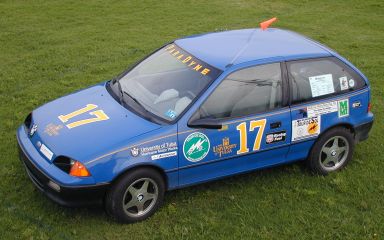
Tulsa Paradyne
Background
The Tulsa Paradyne was initially conceived as a test mule in which a new parallel powertrain could be developed, tested and then installed in the Proxima HEV. These plans changed, however, as the ambitions of Hurricane Motor Works broadened.

The Paradyne, since its initial conversion in 1996, has matured into a fully functioning hybrid electric vehicle. The heart of this HEV is its overrunning (or one-way) clutch. After numerous failures with a roller overrunning clutch, the Works pursued Dana Inc. for the use of their sprag overrunning clutches. This type of clutch now operates successfully in the vehicle. A fully automated control system enables the driver to operate the Paradyne as they would any other automobile. For 2002, the Paradyne's engine has been converted from gasoline to E85 ethanol.
The Paradyne was originally white No. 7, but was repainted blue to match
TU's colors. It kept No. 7 until the 2001 Tour de Sol, when it became No.
17.
Tulsa Paradyne Specifications
Engine and Motor
| Engine | 1 liter 3-cylinder SOHC, liquid-cooled | |
| Motor | Solectria ACTGX20 AC induction | |
| Engine peak horsepower (gasoline) | 45 hp | 33.5 kW |
| Motor peak horsepower | 25.9 hp | 19.3 kW |
| Peak combined torque (gasoline) | 92 ft-lb | 125 Nm |
| Battery pack | 12 x Concorde PVX 1248 VRLA | 144 V |
Drivetrain
| Transmission | Three speed automatic |
| Maximum transmission speed | 6000 rpm |
| Hybrid technology | Parallel hybrid with overrunning clutch |
Body and Chassis
| Layout | Front engine, front wheel drive |
| Body | Steel uni-body |
| Brakes | Regenerative, hydraulic disc and drum |
| Wheels | 14x6 inch, neutral offset |
| Tires | 175/65R14 |
| Steering | Rack and pinion |
| Front suspension | Compressed struts, sway bar |
| Rear suspension | Custom springs, sway bar |
General data
| Curb weight | 2400 lbs | 1090 kg |
| Wheel base | 89.2 in | 2.27 m |
| Length | 147.4 in | 3.74 m |
| Height | 52.4 in | 1.33 m |